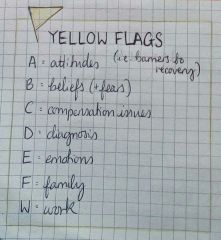![]()
![]()
![]()
Use LEFT and RIGHT arrow keys to navigate between flashcards;
Use UP and DOWN arrow keys to flip the card;
H to show hint;
A reads text to speech;
12 Cards in this Set
- Front
- Back
- 3rd side (hint)
|
Neurogenic shock (cause and signs) |
Cause: SCI > reduced sympathetic outflow (T10-L2) > vasodilation and bradycardia (unlike other types of shock)
Signs: - low HR/BP - neurological deficits - warm, dry skin (vasodilation increases BF) |
|
|
|
Transient neuropraxia |
Transient conduction block of motor/sensory function without nerve degeneration |
|
|
|
Spinothalamic tract sensation |
Pain Temp Pressure Light touch |
|
|
|
Central cord syndrome |
Cause: cervical spondylosis Recovery: LL > bladder > UL > sensation Arms affected more than legs Sacral sparing |
|
|
|
Anterior cord syndrome |
Cause: aortic insufficiency or anterior spinal a. occlusion |
|
|
|
Posterior cord syndrome |
Can result in tetraparesis |
|
|
|
Paresis v plegia |
Paresis = weakness Plegia = paralysis |
|
|
|
Most common tumour... ... IN bone ... of bone marrow ... of bone |
... IN bone = METASTASES... of bone marrow = MYELOMA... of bone = OSTEOSARCOMA |
|
|
|
Red flags |

|
4 8 PMHx 2 SHx 6 |
|
|
Yellow flags |

|
|
|
|
Blue/black flags |

|
|
|
|
Common sites of primary tumours and how they become spinal metastases |

|
BoobsBreatheBumBeanBlood |

